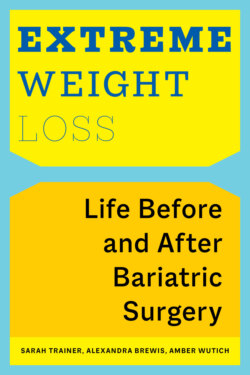Читать книгу Extreme Weight Loss - Amber Wutich - Страница 10
На сайте Литреса книга снята с продажи.
A Word about Language
ОглавлениеThroughout the introduction, we have used a variety of words to describe bodies. These may have included “fat/fatness,” “obese/obesity,” “extreme weight,” “weight,” “morbid obesity,” “higher weight-to-height ratio,” “high body weight,” “very large people,” and (less often, given our focus) “skinny.” At first glance, our usage probably appears casual and haphazard; in fact, it is purposeful and reflects quite a lot of thought.
Common working definitions of all of these terms tend to draw dichotomies between them. For example, “fat” is often treated as a slippery social descriptor, used casually in conversations to self-describe or to describe someone else but without basis in objective physical measures. In other words, someone may be “fat” in certain settings but not in others and to certain audiences but not to others. Moreover, in some settings, using “fat” is derogatory and stigmatizing: “She’s fat and ugly!” would be an all-too-common example of this type of usage (and yes, it is more likely to be “she”). On the other hand, there has been considerable recent pushback in Western settings like the US to this type of deployment, and many activists and adherents of feminist-influenced body-positivity movements now insist that “fat” be used in a positive, empowering sense.
Some researchers focus on “obesity” as a medical term, defined by weight deemed “excessive” after height and weight measures have been obtained from an individual and used to calculate that person’s BMI, or Body Mass Index. “Normal weight” only applies to people whose BMI (based on those height-to-weight ratios) is between 18 and 24.9. “Overweight” applies to individuals with BMIs 25 to 29.9, and “obese” applies to individuals with BMIs of 30 or above. “Obese” is then further subdivided into different categories: Class 1, with BMIs 30 to 34.9; Class 2, with BMIs 35 to 39.9; and Class 3, with BMIs 40 and above.23 People whose weight pushes them into that last category, Class 3 Obesity, are also categorized as “morbidly obese” and, less often, as “extremely obese.”
Does this sound scientific and neatly delineated? In fact, use of “obesity” is almost as messy as use of “fat” as a descriptor. Two major problems emerge upon closer examination. One is that BMI categories are woefully inaccurate and do not take into account muscle mass at an individual level, population-level differences, and gendered differences in weight distribution, to name just a few well-known problems.24 The second is that in everyday practice, Americans often use “obesity” somewhat interchangeably with “fat,” even though the connotations of that usage remain slightly different.25
What does all of this messiness mean for the way we use descriptors here in this book? After some reflection, we decided to deploy all possible descriptors both that we hear used in everyday language in the United States today and that surfaced as influential and common words / embodied states for patients in the bariatric practice where we were engaged. In relating our research findings, we also decided to use these terms in the ways that are faithful to what we observed—that various terms are used interchangeably, fluidly, and very problematically. In the introduction and conclusion, we engage with the literatures that analyze and critique these terms and how they are used to (dis)establish social norms. We hope our approach will help readers become aware of these same terms, and their power to set and challenge norms, in their own lives.
It is nonetheless important to note that the clinic definitely did not share our approach to language and categories. Several health-care providers within the clinic could and did talk very knowledgably with bariatric patients about fat stigma when that arose. In general, however, the clinic relied on traditional BMI-based obesity categories. Indeed, in order to qualify for the surgery, would-be bariatric candidates typically needed to present with a BMI of 40 or above, indicating “morbid obesity.” In this, the clinic reflects common medical and public health practice in the twenty-first century, which overwhelmingly (1) acknowledges that BMIs are conceptually and practically problematic and (2) continues to use them for lack of a clear-cut alternative.
